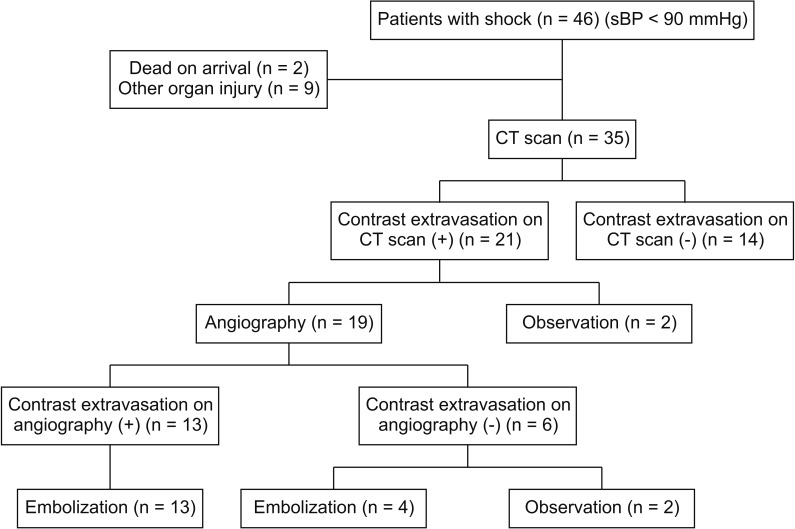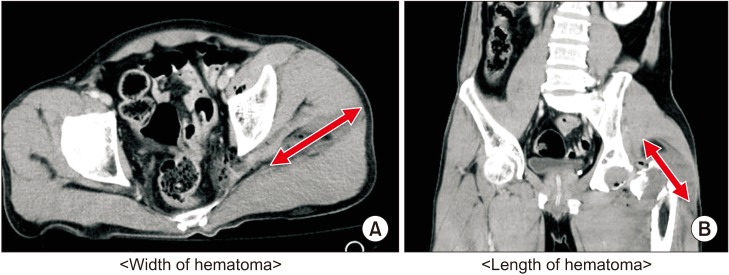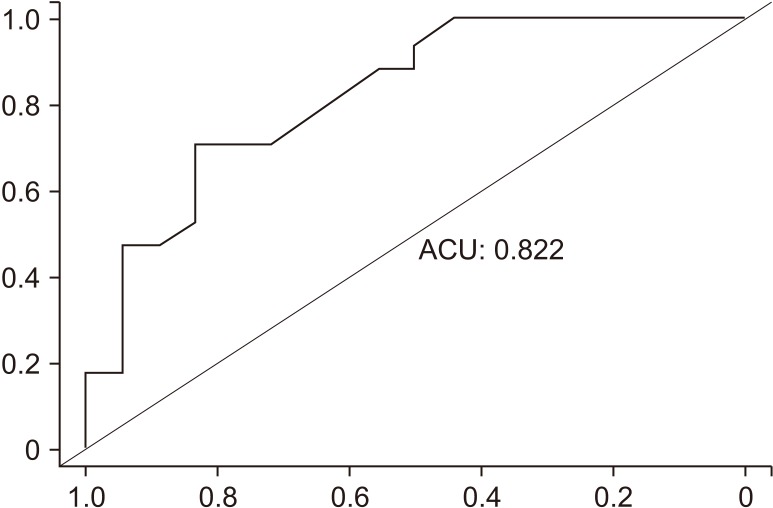Ann Surg Treat Res.
2020 Mar;98(3):146-152. 10.4174/astr.2020.98.3.146.
The size of pelvic hematoma can be a predictive factor for angioembolization in hemodynamically unstable pelvic trauma
- Affiliations
-
- 1Division of Acute Care Surgery, Department of Surgery, Asan Medical Center, University of Ulsan College of Medicine, Seoul, Korea. skhong94@amc.seoul.kr
- 2Korean Army Academy Hospital, Yeongcheon, Korea.
- KMID: 2471180
- DOI: http://doi.org/10.4174/astr.2020.98.3.146
Abstract
- PURPOSE
Unstable pelvic fracture with bleeding can be fatal, with a mortality rate of up to 40%. Therefore, early detection and treatment are important in unstable pelvic trauma. We investigated the early predictive factors for possible embolization in patients with hemodynamically unstable pelvic trauma.
METHODS
From January 2011 to December 2013, 46 patients with shock arrived at a single hospital within 24 hours after injury. Of them, 44 patients underwent CT scan after initial resuscitation, except for 2 who were dead on arrival. Nine patients with other organ injuries were excluded. Seventeen patients underwent embolization. A single radiologist measured the width (longest length in axial view) and length (longest length in coronal view) of pelvic hematoma on CT scans. Demographic, clinical, and radiological data were reviewed retrospectively.
RESULTS
Among 35 patients with hemodynamically unstable pelvic fracture, 22 (62.9%) were men. Width (P = 0.002) and length (P = 0.006) of hematoma on CT scans were significantly different between the embolization and nonembolization groups. The predictors of embolization were width of pelvic hematoma (odds ratio [OR], 1.07; P = 0.028) and female sex (OR, 10.83; P = 0.031). The cutoff value was 3.35 cm. More embolization was performed (OR, 12.00; P = 0.003) and higher mortality was observed in patients with hematoma width >3.35 cm (OR, 4.96; P = 0.048).
CONCLUSION
Patients with hemodynamically unstable pelvic trauma have a high mortality rate. CT is useful for the initial identification of the need for embolization among these patients. The width of pelvic hematoma can predict possible embolization in patients with unstable pelvic trauma.
MeSH Terms
Figure
Reference
-
1. El-Haj M, Bloom A, Mosheiff R, Liebergall M, Weil YA. Outcome of angiographic embolisation for unstable pelvic ring injuries: factors predicting success. Injury. 2013; 44:1750–1755. PMID: 23796438.
Article2. Hymel A, Asturias S, Zhao F, Bliss R, Moran T, Marshall RH, et al. Selective versus nonselective embolization versus no embolization in pelvic trauma: a multicenter retrospective cohort study. J Trauma Acute Care Surg. 2017; 83:361–367. PMID: 28463936.3. Tanizaki S, Maeda S, Matano H, Sera M, Nagai H, Ishida H. Time to pelvic embolization for hemodynamically unstable pelvic fractures may affect the survival for delays up to 60 min. Injury. 2014; 45:738–741. PMID: 24314873.4. Tesoriero RB, Bruns BR, Narayan M, Dubose J, Guliani SS, Brenner ML, et al. Angiographic embolization for hemorrhage following pelvic fracture: is it “time” for a paradigm shift? J Trauma Acute Care Surg. 2017; 82:18–26. PMID: 27602911.5. White CE, Hsu JR, Holcomb JB. Haemodynamically unstable pelvic fractures. Injury. 2009; 40:1023–1030. PMID: 19371871.
Article6. Coccolini F, Stahel PF, Montori G, Biffl W, Horer TM, Catena F, et al. Pelvic trauma: WSES classification and guidelines. World J Emerg Surg. 2017; 12:5. PMID: 28115984.
Article7. Cullinane DC, Schiller HJ, Zielinski MD, Bilaniuk JW, Collier BR, Como J, et al. Eastern Association for the Surgery of Trauma practice management guidelines for hemorrhage in pelvic fracture--update and systematic review. J Trauma. 2011; 71:1850–1868. PMID: 22182895.
Article8. Dalal SA, Burgess AR, Siegel JH, Young JW, Brumback RJ, Poka A, et al. Pelvic fracture in multiple trauma: classification by mechanism is key to pattern of organ injury, resuscitative requirements, and outcome. J Trauma. 1989; 29:981–1000. PMID: 2746708.9. Smith W, Williams A, Agudelo J, Shannon M, Morgan S, Stahel P, et al. Early predictors of mortality in hemodynamically unstable pelvis fractures. J Orthop Trauma. 2007; 21:31–37. PMID: 17211266.
Article10. Yoon W, Kim JK, Jeong YY, Seo JJ, Park JG, Kang HK. Pelvic arterial hemorrhage in patients with pelvic fractures: detection with contrast-enhanced CT. Radiographics. 2004; 24:1591–1605. PMID: 15537967.
Article11. Brun J, Guillot S, Bouzat P, Broux C, Thony F, Genty C, et al. Detecting active pelvic arterial haemorrhage on admission following serious pelvic fracture in multiple trauma patients. Injury. 2014; 45:101–106. PMID: 23845571.
Article12. Velmahos GC, Toutouzas KG, Vassiliu P, Sarkisyan G, Chan LS, Hanks SH, et al. A prospective study on the safety and efficacy of angiographic embolization for pelvic and visceral injuries. J Trauma. 2002; 53:303–308. PMID: 12169938.
Article13. Salim A, Teixeira PG, DuBose J, Ottochian M, Inaba K, Margulies DR, et al. Predictors of positive angiography in pelvic fractures: a prospective study. J Am Coll Surg. 2008; 207:656–662. PMID: 18954776.
Article14. Anandakumar V, Hussein FK, Varuun B, Zhu R. Predictive parameters for angiography and embolization in the bleeding pelvic fracture. J Clin Orthop Trauma. 2013; 4:70–74. PMID: 26403627.
Article15. Demetriades D, Karaiskakis M, Toutouzas K, Alo K, Velmahos G, Chan L. Pelvic fractures: epidemiology and predictors of associated abdominal injuries and outcomes. J Am Coll Surg. 2002; 195:1–10. PMID: 12113532.16. Blackmore CC, Cummings P, Jurkovich GJ, Linnau KF, Hoffer EK, Rivara FP. Predicting major hemorrhage in patients with pelvic fracture. J Trauma. 2006; 61:346–352. PMID: 16917449.
Article17. Suzuki T, Smith WR, Moore EE. Pelvic packing or angiography: competitive or complementary? Injury. 2009; 40:343–353. PMID: 19278678.
Article18. Burlew CC, Moore EE, Stahel PF, Geddes AE, Wagenaar AE, Pieracci FM, et al. Preperitoneal pelvic packing reduces mortality in patients with life-threatening hemorrhage due to unstable pelvic fractures. J Trauma Acute Care Surg. 2017; 82:233–242. PMID: 27893645.
Article19. Pereira SJ, O'Brien DP, Luchette FA, Choe KA, Lim E, Davis K Jr, et al. Dynamic helical computed tomography scan accurately detects hemorrhage in patients with pelvic fracture. Surgery. 2000; 128:678–685. PMID: 11015102.
Article20. Eastridge BJ, Starr A, Minei JP, O'Keefe GE, Scalea TM. The importance of fracture pattern in guiding therapeutic decision-making in patients with hemorrhagic shock and pelvic ring disruptions. J Trauma. 2002; 53:446–450. PMID: 12352479.
Article21. Blackmore CC, Jurkovich GJ, Linnau KF, Cummings P, Hoffer EK, Rivara FP. Assessment of volume of hemorrhage and outcome from pelvic fracture. Arch Surg. 2003; 138:504–508. PMID: 12742953.
Article22. Brown CV, Kasotakis G, Wilcox A, Rhee P, Salim A, Demetriades D. Does pelvic hematoma on admission computed tomography predict active bleeding at angiography for pelvic fracture? Am Surg. 2005; 71:759–762. PMID: 16468513.
Article23. Holstein JH, Culemann U, Pohlemann T. Working Group Mortality in Pelvic Fracture Patients. What are predictors of mortality in patients with pelvic fractures? Clin Orthop Relat Res. 2012; 470:2090–2097. PMID: 22354608.
Article24. Huber-Wagner S, Biberthaler P, Haberle S, Wierer M, Dobritz M, Rummeny E, et al. Whole-body CT in haemodynamically unstable severely injured patients--a retrospective, multicentre study. PLoS One. 2013; 8:e68880. PMID: 23894365.
- Full Text Links
- Actions
-
Cited
- CITED
-
- Close
- Share
- Similar articles
-
- Management Trend for Unstable Pelvic Bone Fractures in Regional Trauma Centers: Multi-Institutional Study in the Republic of Korea
- The Importance of the Trauma Surgeon: A Reflection on the Management of Hemodynamically Unstable Pelvic Trauma Patients
- Comparisons of Fracture Types and Pelvic Angiographic Findings in Hemodynamically Unstable Pelvic Bone Fracture
- Comparison of the Mortality Rate according to the Presence of Trauma Team in Hemodynamically Unstable Patients with Pelvic Ring Injury
- Pelvic Fracture Classification, Associated Injury and Hemodynamic Change




